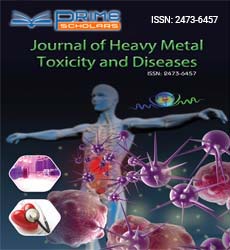Perspective - (2024) Volume 9, Issue 5
Environmental Remediation: Effective Techniques for Removing Heavy Metals from Contaminated Sites
Longyu Tian*
Department of Biomedical Engineering, Huazhong University, China
*Correspondence:
Longyu Tian,
Department of Biomedical Engineering, Huazhong University,
China,
Email:
Received: 01-Oct-2024, Manuscript No. ipjhmct-24-21857;
Editor assigned: 03-Oct-2024, Pre QC No. ipjhmct-24-21857 (PQ);
Reviewed: 17-Oct-2024, QC No. ipjhmct-24-21857;
Revised: 22-Oct-2024, Manuscript No. ipjhmct-24-21857 (R);
Published:
29-Oct-2024, DOI: 10.21767/2473-6457.24.5.44
Introduction
Heavy metal contamination is a significant environmental issue
that poses serious risks to human health, ecosystems, and water
quality. Metals such as lead, mercury, arsenic, and cadmium can
accumulate in soils, sediments, and water bodies, resulting from
industrial processes, mining activities, agricultural practices, and
improper waste disposal. The need for effective remediation
techniques is critical to restoring contaminated sites and
protecting public health. This article explores various methods
for removing heavy metals from contaminated environments,
highlighting their mechanisms, effectiveness, and challenges.
Description
Heavy metals are naturally occurring elements that can become
toxic when present in excessive amounts. They can enter the
environment through various pathways, including industrial
discharges, urban runoff, and atmospheric deposition. Once
released, these metals can persist in the environment due to their
stability and tendency to bioaccumulate in living organisms. The
consequences of heavy metal contamination can be profound,
leading to adverse health effects in humans, wildlife, and plants.
Therefore, remediation strategies are essential for mitigating
these risks. One of the most direct methods for remediation
is the physical removal of contaminated soil. This technique
involves excavating the contaminated soil and transporting it to a
designated disposal site or treatment facility. Soil excavation can
effectively eliminate heavy metal sources and prevent further
leaching into the environment. This method can be costly and
labor-intensive, requiring significant resources for transportation
and disposal. Additionally, it may not address the underlying
contamination in deeper soil layers or groundwater. Soil washing
is a physical-chemical remediation technique that uses water,
surfactants, and chemical additives to remove heavy metals from
contaminated soil. The process involves mixing contaminated soil
with a washing solution that solubilizes heavy metals, allowing
them to be separated from the soil particles. Soil washing can
achieve high removal rates for certain metals, and the treated
soil can often be reused or returned to the site. This method
generates wastewater that requires further treatment to remove
dissolved metals, adding complexity to the remediation process.
Chemical stabilization involves adding reagents to contaminated
soil or sediment to immobilize heavy metals, preventing their
release into the environment. Reagents such as phosphates,
lime, or organic amendments can bind heavy metals, reducing
their mobility and bioavailability. This method can be effective
in treating specific metals and is often used as a complementary
approach to other remediation techniques. While stabilization
reduces immediate risks, it does not remove the metals from
the environment. Long-term monitoring is necessary to ensure
effectiveness. Bioremediation leverages biological processes,
particularly the activity of microorganisms, to degrade or
immobilize heavy metals in contaminated environments.
Bioremediation can be a cost-effective and environmentally
friendly approach, with the potential for complete remediation
of contaminants over time. The effectiveness of bioremediation
can vary based on environmental conditions and the specific
metals involved. Additionally, it may require longer timeframes
to achieve desired outcomes.
Conclusion
Effective remediation of heavy metal-contaminated sites is crucial
for protecting human health and restoring environmental quality.
Various techniques, including soil excavation, soil washing,
chemical stabilization, bioremediation, thermal desorption, and
phytoremediation, offer different benefits and challenges. The
choice of remediation method depends on factors such as the
type and extent of contamination, site conditions, and available
resources. As research and technology continue to evolve,
integrating multiple remediation approaches may yield the best
results, leading to more efficient and sustainable solutions for
addressing heavy metal contamination.
Citation: Tian L (2024) Environmental Remediation: Effective Techniques for Removing Heavy Metals from Contaminated Sites. J Heavy Met Toxicity Dis. 09:44.
Copyright: © 2024 Tian L. This is an open-access article distributed under the terms of the Creative Commons Attribution License, which permits unrestricted use, distribution, and reproduction in any medium, provided the original author and source are credited.

